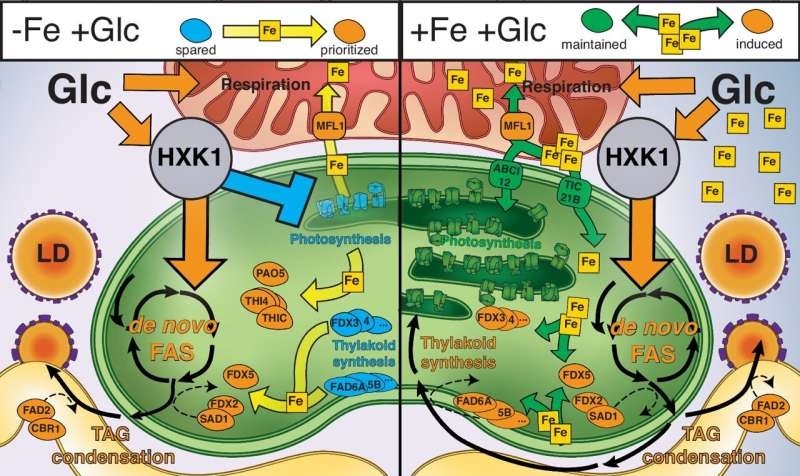Researchers have discovered that the green alga Chromochloris zofingiensis can maintain photosynthesis and accumulate lipids for biofuel production when grown with iron supplements and glucose. This study provides a roadmap to enhance bioenergy crops and bioproducts.

Balancing photosynthesis and lipid production
Chromochloris zofingiensis is a single-cell green alga with potential benefits for research in photosynthesis and metabolism. Earlier studies had shown that when Chromochloris zofingiensis is given glucose, it will turn off photosynthesis and instead direct its metabolism towards accumulating high levels of lipids (precursors to biofuels) and astaxanthin (a valuable antioxidant).
The researchers at EMSL and the University of California, Berkeley, however, found them to be better than that. For example in the presence of an iron supplement and glucose, cells were able to remain photosynthetically proficient and maintain thylakoid membranes (the site for energy transfer during photosynthesis) while accumulating lipids. Interestingly, this indicates that by precisely tuning the environment and availability of nutrients cells finding balance in photosynthesis versus lipid production can occur.
Revealing The Metabolic Blueprint
Advanced methods were employed to dissect intricate metabolic pathways that are involved in the activity of the expanded pyramidal cells. EMSL researchers used proteomic analyses to provide a closer look at the metabolic rewiring that accompanied the loss of photosynthesis and lipid accumulation.
The strength of EMSL’s transmission electron microscopy capability was called upon to image the organelles, thylakoid development, and starch as well as oil production within cells. These findings in conjunction with physiological studies led the team to conclude that glucose-dependent photosynthesis repression is caused by a re-prioritization of cellular iron resources. Instead of contributing to the iron demands of photosynthetic complexes, it is apportioned for respiratory complexes and used to generate lipids rather than thylakoid lipids.
Also, researchers found a ferredoxin-dependent desaturase pathway that diverts lipids to storage without integrating them into the thylakoid membranes. The secret to unleashing Chromochloris zofingiensis’ biofuel production prowess includes striking a delicate balance between photosynthesis and lipid synthesis.
Conclusion
This study, a breakthrough on the green alga Chromochloris zofingiensis, provides an understanding of how nutrient availability, metabolic constraints, and photosynthetic processes can interact to modulate the kinetic properties of acetyl-CoA metabolism. The researchers identified the key to maintaining photosynthesis and at the same time allowing sugar production but not growth–the channel formed by PAPs–and with this discovery, have guided how to engineer bioenergy crops for increased storage of lipids. Such knowledge might inform more energy and environmentally-friendly biofuels that could bring society closer to the promise of a greener future.
